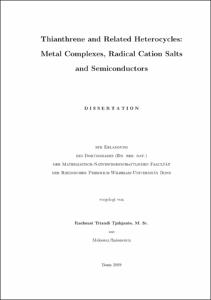Thianthrene and Related HeterocyclesMetal Complexes, Radical Cation Salts and Semiconductors

Thianthrene and Related Heterocycles
Metal Complexes, Radical Cation Salts and Semiconductors

| dc.contributor.advisor | Beck, Johannes | |
| dc.contributor.author | Tjahjanto, Rachmat Triandi | |
| dc.date.accessioned | 2020-04-14T01:40:56Z | |
| dc.date.available | 2020-04-14T01:40:56Z | |
| dc.date.issued | 22.07.2009 | |
| dc.identifier.uri | https://hdl.handle.net/20.500.11811/4107 | |
| dc.description.abstract | Liquid SO2 was used as a solvent for complexation as well as redox reactions based on thianthrene and related heterocyclic molecules. With silver salt, AgX (X = BF4-, SbF6-), the complexes [Ag2(TA)2][BF4]2 · 3 SO2 (1) and [Ag2(TA)3][SbF6 ]2 · 5 SO2 (2), and with gold(III) chloride, the complex [AuCl2(TA)2][AuCl4] (3) were obtained. The oxidation products contain radical cations of thianthrene, TA·+, as found in the structure of (TA·)(HSO4) · H2SO4 (5) and (TA·)[FeCl4] (6), radical cation of selenanthrene in the structure of (SA·)[AlCl4] (8) and (SA·)2[SO4(BF3)2] (10), and a structure with a bridging oxygen of µ-oxy-selenanthrene(2+), SAO(HSO4)2 (9). The reaction between thianthrene and aluminum chloride was also performed without solvent, resulting in an adduct [AlCl3(TA)] (4) and a unique thianthrene "triple decker", (TA3)[Al2Cl7]2 (7). An unexpected phenazine salt, (H2PAz)(HSO4)2 (11) was obtained from phenazine in an oxidative environment. All compounds were examined by single crystal X-ray diffractometry. The gold and aluminum complexes were additionally characterized by UV-Vis, IR and Raman spectra, calorimetry and conductivity measurements. Cyclic voltammetry measurements of thianthrene in SO2 at room temperature were performed using a self-made pressure-tight electrochemical cell and electrodes with the result that liquid SO2 does not reduce the oxidation potential of thianthrene. The influence of SO3, which is often present in liquid SO2 as impurity, was also studied, confirming its role in the oxidation of thianthrene. The use of liquid SO2 combined with weak coordinating anions allows complexation of silver ion with higher coordination number, bonded to thianthene via S atoms. SO3 as an impurity in liquid SO2 is the most probable source for oxidation reaction leading to the compounds containing radical cations. Thianthrene undergoes self-oxidation processes in the presence of AlCl3, both with or without solvent. Close TA · · · TA arrangements in the crystal structures should be an indication of the electrical semiconductivity. | en |
| dc.language.iso | eng | |
| dc.rights | In Copyright | |
| dc.rights.uri | http://rightsstatements.org/vocab/InC/1.0/ | |
| dc.subject.ddc | 540 Chemie | |
| dc.title | Thianthrene and Related Heterocycles | |
| dc.title.alternative | Metal Complexes, Radical Cation Salts and Semiconductors | |
| dc.type | Dissertation oder Habilitation | |
| dc.publisher.name | Universitäts- und Landesbibliothek Bonn | |
| dc.publisher.location | Bonn | |
| dc.rights.accessRights | openAccess | |
| dc.identifier.urn | https://nbn-resolving.org/urn:nbn:de:hbz:5N-18274 | |
| ulbbn.pubtype | Erstveröffentlichung | |
| ulbbnediss.affiliation.name | Rheinische Friedrich-Wilhelms-Universität Bonn | |
| ulbbnediss.affiliation.location | Bonn | |
| ulbbnediss.thesis.level | Dissertation | |
| ulbbnediss.dissID | 1827 | |
| ulbbnediss.date.accepted | 17.07.2009 | |
| ulbbnediss.institute | Mathematisch-Naturwissenschaftliche Fakultät : Fachgruppe Chemie / Institut für Anorganische Chemie | |
| ulbbnediss.fakultaet | Mathematisch-Naturwissenschaftliche Fakultät | |
| dc.contributor.coReferee | Filippou, Alexander Constantin |
Files in this item
This item appears in the following Collection(s)
-
E-Dissertationen (4405)




